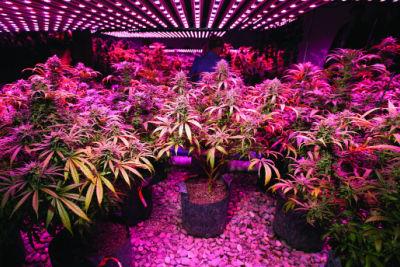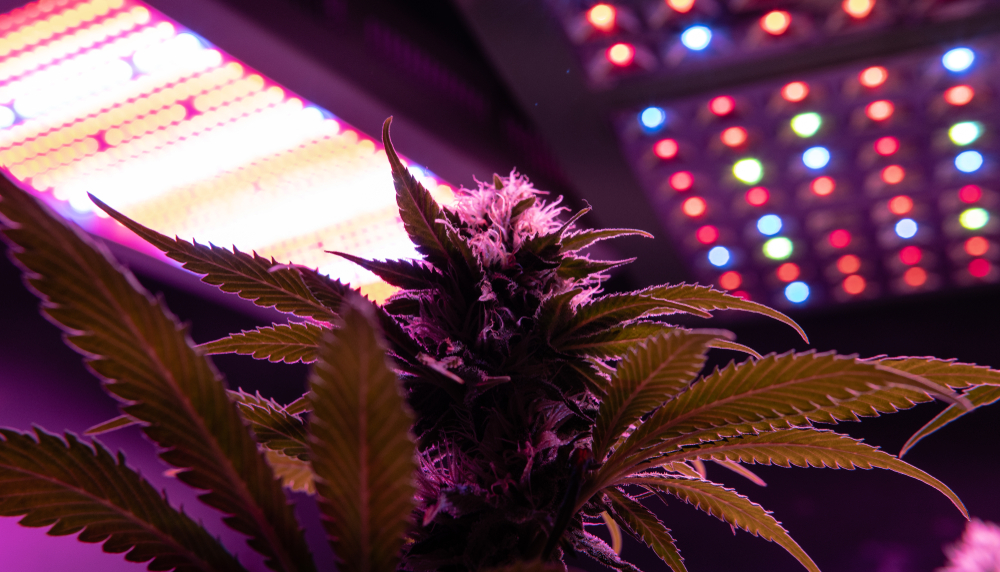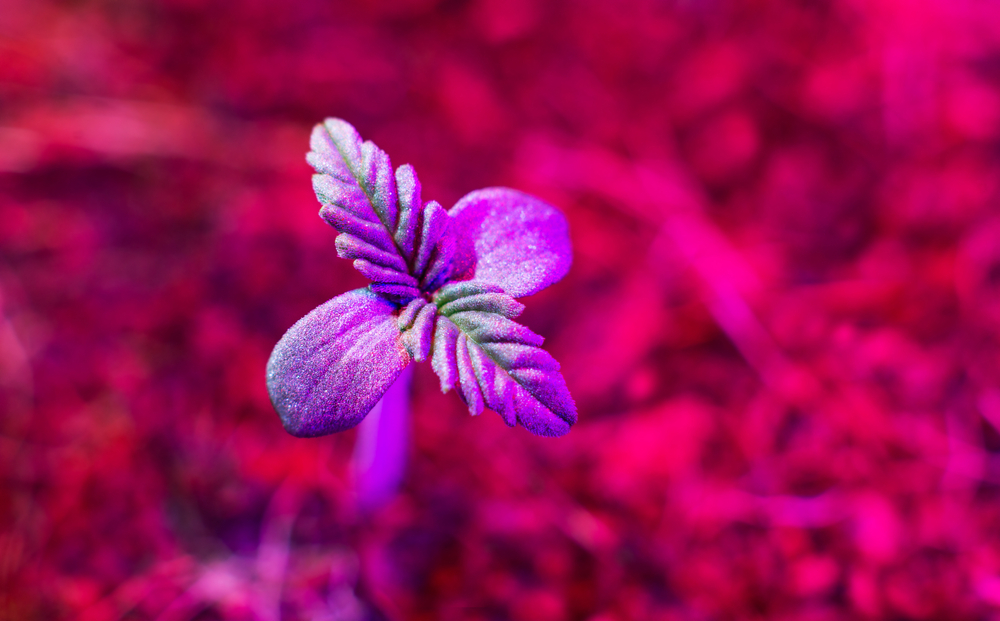
Tuesday June 13, 2023
By Trevor Ross
 Growing
Growing
A “photoperiod,” from the Greek root photo meaning light, is a period of time exposed to light, generally a cycle of light and dark. The term is applied to plants because many plants begin producing flowers based on the length of the day. This is why some plants bloom in spring while others bloom in fall. In fact, all photoperiodic plants can be placed in one of two categories: long-day plants like peas and spinach which flower when the days are long, and short-day plants like rice and cotton which flower when the days are short. Cannabis is a short-day plant.
Not only do the hours of light matter, but the color of light matters as well. Many LED grow lights offer a “full spectrum” of light from blues to reds. This is because in nature, as the days grow shorter, the light that reaches plants on the ground is actually redder.
This article reviews photoperiod manipulation for marijuana, the role of red light versus blue light, and explores autoflowering marijuana as an alternative.
Red Light, Blue Light, and Cannabis
Let’s begin with a crash course in earth science because to fundamentally understand photoperiod manipulation, growers should understand the photoperiod we are manipulating. Plants are looking for multiple cues from mother nature to produce flowers, and growers are responsible for replicating that process as effectively as possible. So here’s how mother nature does it.
Many plants, including cannabis, have hormones and various cell-signaling compounds that are collectively referred to as “florigen.” These hormones help regulate the plant’s life cycle in conjunction with its circadian rhythm, and they are influenced as much by the hours of daylight available for absorption as they are by the color of light being absorbed.

The spectrum of light, every color in the rainbow from red to violet, is the visible expression of electromagnetic waves that measure between 700 nanometers on the red end to 400 nm on the violet end. These two ends of the visible light spectrum are commonly categorized as red light and blue light. To a cannabis plant, blue light, with its shorter wavelengths, resembles the light of spring, while red light, at longer wavelengths, resembles autumn. And since cannabis is a short-day plant, that autumnal light signals to the plant that it’s time to bloom.
When sunlight, all the possible light from 400 - 700 nanometers, reaches earth’s atmosphere, it’s diffused and scattered into ambient daylight with shorter wavelengths (blue light) scattering first—which is why the sky is blue! As blue light scatters, more red light reaches the surface.
During spring and summer, the hemisphere experiencing those seasons is tilted toward the sun, and during fall and winter, that hemisphere is tilted away from the sun. Direct sunlight in the spring and summer is not more blue exactly, but the indirect sunlight of fall and winter is more red because by passing through the atmosphere at an angle, thus taking a longer path to the ground, more blue light is diffused, so the remaining light that reaches the surface of the earth is inevitably more red.
That, in a nutshell, is why vegetative stages call for blue light, and flowering stages require red light, and why autumn afternoons offer such enchanting amber glows.
Photoperiod Manipulation for Marijuana
Equally important, if not more so than the color of light, is the duration of light cycles during the growing process. Because cannabis is so sensitive to seasonal patterns, it must have a rhythmic lighting cycle, and any deviation from it can stunt growth, and in extreme cases can stress the plant into producing seeds instead of flowers.

Achieving photoperiod manipulation for marijuana indoors, like in a grow tent, is much easier. As previously stated, lights can be changed with the flip of a switch, or even less. Timers can be plugged in between most lights and their outlet and then programmed to turn on and off at desired intervals. The biggest challenge indoors will be “light leaks,” or light leaking into the tent or grow room through cracks, seams, and pinholes. If your plant is showing mysterious signs of stress, consider sealing up any potential light leaks with duct tape or black electrician’s tape. It’s not a perfect solution, but it will at least help growers isolate the problem, and in many cases will suffice through the end of the growing process.
Outdoor growers have a steeper challenge. Whether growing outdoors or in a greenhouse, some kind of structure or system will be necessary to cast shade on the plants, whether it be tarps or shade sails, or even just pots on wheels that are rolled in and out of the sunlight. Photoperiod manipulation under the sun means staying one step ahead of the sun. The sun’s hours will change predictably, but relentlessly, meaning growers cannot miss a day of adjusting for darkness. Those growing for maximum yield should not miss an hour.
Autoflowering Cannabis
Autoflowering cannabis offers a viable alternative to much of the information above. Since photoperiod plants produce flowers on certain light cues, they can actually be suspended in the vegetative stage under blue light, growing larger without ever being prompted to produce buds. Autoflowering cannabis, on the other hand, will produce flowers after a certain amount of time regardless of the hours or color of light it is exposed to. This makes it an attractive option to growers far from the equator with shorter, colder growing days, or to novice growers who want to try growing cannabis with fewer factors to juggle.
On average, autoflowering plants tend to produce smaller yields, about 10-12 oz compared to 14-16 from a good photoperiod plant. But for many growers, especially those growing multiple plants, the smaller yield is a fair concession for an easier growing process, and often a shorter one too. Many autoflowering strains can be harvested in 10 weeks, as opposed to 16 weeks or more for photoperiod plants.
Conclusion
Photoperiod manipulation has been integral to indoor cannabis for generations, but it can also be done outdoors with some preparation and tenacity. Manipulating the sun directly from the source requires vigilance and offers no days off, so it’s far easier to achieve indoors, especially with LEDs that come equipped with red and blue light settings. Many grow lights now also include far-red light (FR), which at a wavelength of about 750 nanometers is nearly invisible to the human eye but increasingly thought to be “visible” to plants, and to further encourage floral growth.
Do you have any photoperiod manipulation tips? Share them below!
FAQs
How do you manipulate a photoperiod
Photoperiod manipulation is the practice of managing a plant’s exposure to light and dark cycles. Most often, this is achieved indoors or in isolated growing rooms with lights on timers, or else lights are adjusted manually. Outdoors, this is usually achieved with structures around the plant that support shades or coverings to block sunlight. In greenhouses, shades are often rigged to be pulled over whole sections of the structure.
The goal is usually to prompt the plant into flowering early, and in doing so, fit more life cycles into a single growing season.
Do cannabis flowers need light?
Yes. Like all plants, cannabis metabolizes light into energy in a process called photosynthesis. Depriving cannabis of light is similar to starving it, and it will die.







